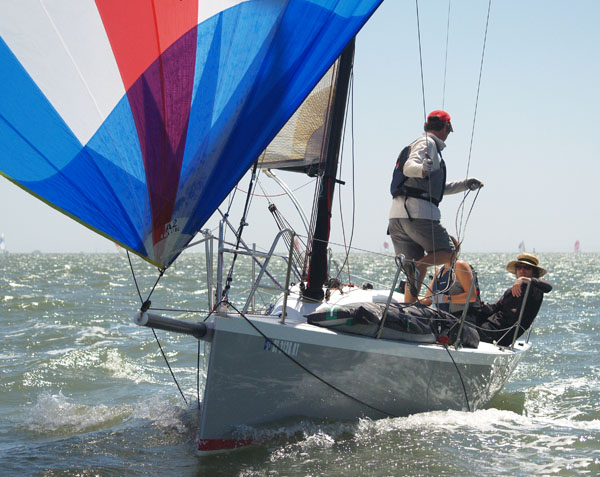
special report
| home | contact us | movies | galleries | recent stories | archived stories | store |

 |
| Brooks Dees' GP 26 Salt Peanuts in the 2008 Jazz Cup race to Benicia. ©2010 norcalsailing.com |
|
Consternation Over New Downwind Ratings April 19 , 2010 Some of our readers comment on the new downwind ratings: Nick Salvador: "Can someone explain to me how an Express 37 rates three seconds per mile SLOWER downwind than around the buoys? Seriously now, how does an Express 27 go from 129 to 96 and an Express 37 get slower? Someone's dartboard needs to be re-calibrated." Foster Atwood: "No Downwind Rating on any of the cat-rigged boats like the Wyliecat 30 or Nonsuch. I bet it is a sticky subject. If we are just talking sail area and LWL [Length at Water Line], and wetted surface..." David Nabors: "I believe there's lots of inaccurate LWL and displacement data on people's PHRF certificates. The downwind pseudo-VPP [Velocity Prediction Program] seems to be pretty sensitive." This year marks the debut of the new downwind ratings under PHRF. With comments like these, we know we will be in a for a wild ride in the Delta Ditch Run and other downwind races. (The Ditch Run is the first race affected; the Great Vallejo Race will be run using traditional ratings. The Jazz Cup may be another race using the downwind rating.) But before you write that nasty email to the local PHRF board, let's have a little history lesson about the whole PHRF ratings game. The rating was developed in Southern California right after WWII, replacing the CCA rule developed for cruising boats, and has been controversial ever since. Back in 1949 they didn't have Melges 24s or Wylie Wabbits and other planing boats. Fast-forward to 2010, and the Northern California board has finally decided bring all the sportboats under control with a formula that supposedly levels the playing field. Sailmaker Kame Richards, a member of the PHRF board says, "The downwind ratings are not a shift on the regular PHRF ratings, they are a whole new system. Racers should only look at the deltas in relation to the other boats' downwind rating. There are variables in the system, and any rating has its problems, but we feel this is a fair way to compensate for a problem that has been with us for a while." Naval architect Jim Antrim also had his hand in the new ratings. "We started with modifications of the PCR formula and developed more from there. We've looked at a lot of past races to develop the base, and what we've figured out so far looks pretty good. And this is different than the Southern California rating formula. This is just our thing." That doesn't mean the ratings are set forever, as PHRF is supposed to be an adjustable system that can change ratings if needed. One of the problems with PHRF downwind or upwind is that the boat measurements are strictly voluntary. The idea from the beginning was an inexpensive self-policing measurement system. "But the brochure measurements are usually way off," remarked naval architect Paul Kamen, a YRA board Member at Large. "The manufacturers lie about weight, for one thing. Most boats are at least ten percent heavier than listed, and waterline length is hard enough to measure correctly for IRC so that's probably way off also." And what of all the complaints flowing in to the YRA these days? "The irrational behavior of a lot of the boat owners is a little surprising to me," says Kame. "We are left with the impression that nobody can win - everybody's rating is so wrong that nobody can win. You know what your boat is designed to do. Somebody's going to win."
And even though you may think they are out to get you, look at the winner of the biggest hit award, Arcadia, the modified Santana 27 and her owners Gordie Nash and Ruth Suzuki. "The nice thing about going from 135 to 75 is I'll be starting in clear air," jokes Gordie. "They have to do something, and this is their first try. Hopefully things will be sorted out. We will do the Delta Ditch Run and have a lot of fun, as it's a great race." So the five things to remember before you despair are: 1. This was needed eventually. 2. It's the first year, so don't panic yet. 3. The PHRF board are not evil (they are boat owners too). 4. Ratings will change if needed. And, 5. Do the Ditch Run - it's a lot of fun.
|